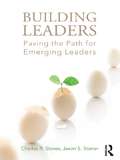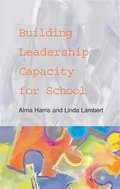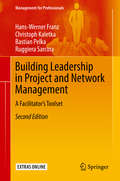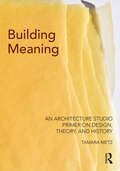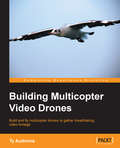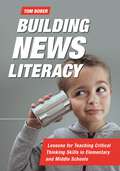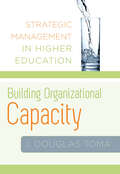- Table View
- List View
Building Knowledge in Higher Education: Enhancing Teaching and Learning with Legitimation Code Theory (Legitimation Code Theory)
by Christine Winberg Sioux McKenna Kirstin WilmotFrom pressures to become economically efficient to calls to act as an agent of progressive social change, higher education is facing a series of challenges. There is an urgent need for a rigorous and sophisticated research base to support the informed development of practices. Yet studies of educational practices in higher education remain theoretically underdeveloped and segmented by discipline and country. Building Knowledge in Higher Education illustrates how Legitimation Code Theory is bringing research together from across the disciplinary map and enabling practical change in a rigorously theorized way. The volume addresses both students and educators. Part I explores ways of supporting student achievement from STEM to the arts, from introductory courses to doctoral training, and from using new digital media to reflective writing. Part II focuses on academic staff development in higher education, reaching from curriculum design to pedagogic practices. All chapters focus on issues of contemporary relevance to higher education, showing how Legitimation Code Theory enables these issues to be understood and practices improved. Building Knowledge in Higher Education brings together internationally renowned scholars in higher education studies, academic development, academic literacies, and sociology, with some of the brightest new researchers. The volume significantly extends understandings of teaching and learning in changing higher education contexts and so contributes to educational research and practice. It will be essential reading not only to scholars and students in these fields but also to scholars and educators in higher education more generally.
Building Leaders: Paving the Path for Emerging Leaders
by Charles R. Stoner Jason S. StonerThis book is written for emerging leaders. It is designed to help these leaders bridge the gap from stepping into a position of leadership and emerging as a confident and respected difference-maker. Within this text, award-winning scholar and leader-coach Charles Stoner meets emerging leaders where they are and focus on the issues that are most problematic for them. From the development of leadership skills to the practice and application of successful strategies, Stoner offers tools, ideas, and evidence-based advice to these up-and-coming leaders in an indispensable text that is direct, pragmatic, and action-oriented. Major topics include: Recognition, development, and practice of organizational leadership skills. Enhancing interpersonal dynamics and relationships. Organizational politics and interpersonal influence, creativity and innovation, negotiation and conflict resolution. Handling problem situations; effectively utilizing diverse talents and personalities. Introduction to major leadership and interpersonal development techniques. Case studies.
Building Leaders: Paving the Path for Emerging Leaders
by Charles R. Stoner Jason S. StonerThis book is written for emerging leaders. It is designed to help these leaders bridge the gap from stepping into a position of leadership and emerging as a confident and respected difference-maker. Within this text, award-winning scholar and leader-coach Charles Stoner meets emerging leaders where they are and focus on the issues that are most problematic for them. From the development of leadership skills to the practice and application of successful strategies, Stoner offers tools, ideas, and evidence-based advice to these up-and-coming leaders in an indispensable text that is direct, pragmatic, and action-oriented. Major topics include: Recognition, development, and practice of organizational leadership skills. Enhancing interpersonal dynamics and relationships. Organizational politics and interpersonal influence, creativity and innovation, negotiation and conflict resolution. Handling problem situations; effectively utilizing diverse talents and personalities. Introduction to major leadership and interpersonal development techniques. Case studies.
Building Leadership Capacity for School Improvement (UK Higher Education OUP Humanities & Social Sciences Education OUP)
by Alma Harris Linda Lambert* What form of leadership promotes school improvement?* How do schools build leadership capacity?* How do schools sustain improvement in changing times?This book offers a new perspective on the relationship between leadership and school improvement. It emphasises the importance of maximising the leadership capabilities of all those within the organization and offers guidance about the way in which this is achieved. Whilst drawing upon the latest research evidence concerning schools improvement, it is intended to be a practical guide to building leadership capacity and is written primarily for those working in schools. Through case study illustrations Alma Harris and Linda Lambert demonstrate how leadership capacity can be built in schools in very different contexts. Practical material is provided to assist schools in generating the internal capacity for change and development. The central message of this book is one of investing in leadership at all levels within the organization to maintain and sustain school improvement.
Building Leadership Development Programmes: Zero-Cost to High-Investment Programmes that Work
by Nigel PaineMost leadership development runs on rails: courses are organized with standard content usually delivered by companies set up expressly for that purpose. Most leadership programmes fail when judged on whether they achieve lasting impact and behaviour change because what is covered is often forgotten after the programme ends. Building Leadership Development Programmes is designed to show how leadership development should work. It challenges the widely accepted notion that leadership development cannot be measured and it exemplifies how to design programmes that are in line with organizational needs and deliver lasting and measurable impact. Building Leadership Development Programmes is structured around detailed case studies from around the world that offer unique insights into the process of building effective leadership development, looking at a range of approaches from almost zero cost options to high end investment that actually works. It helps readers think through what it is that they are actually trying to achieve, offering processes to work through to establish what is necessary for their organization and take a longer view than looking for quick fixes. It features case studies including Crotonville Leadership Centre who have worked with GE, McKinsey and the Red Cross, and interviews with world authorities on leadership and talent development. Detailed guidance will help identify the right measures to ensure impact, and to adopt the right methodologies, including looking at leadership coaching, mentoring, social learning and action learning, blowing apart the idea that expensive training courses are always required.
Building Leadership in Project and Network Management (PDF)
by Hans-Werner Franz Christoph Kaletka Bastian Pelka Ruggiera SarcinaThis book introduces readers to essential facilitation techniques for leadership in the contexts of project and network management. It provides method-based messages, a facilitator curriculum, and a veritable arsenal of 50 carefully selected and 'reality-tested' tools for facilitation in non-hierarchical contexts. As such, readers will benefit just as much from learning by doing as from doing by learning. This book is also intended for all managers who are responsible for successful communication and co-operation in projects in and across organisations or networks of organisations, and who want to know how to share their plans effectively and improve collaboration. Though the book employs scientific principles, it is chiefly a practical guide, and draws on the authors’ extensive experience in consultancy and management.
Building Learning Capacity in an Age of Uncertainty: Leading an Agile and Adaptive School
by James A. BaileyIn an increasingly complex context of global pandemic, economic uncertainty, increased racial inequities, and a climate crisis, this practical guide for school leaders explores how capacity as learning at the individual, team, and organizational level can help schools become more agile and adaptive. Author James A. Bailey unpacks a new model of capacity building that combines learning process, leadership mindsets, and skills to enhance learning. This research-based book includes a "Diagnostic for School Learning Capacity" and "Team Considerations" to help school leaders and their teams launch further discussions and advance learning in their contexts. The tools in this timely book are designed to help school leaders handle the increasing volatile, uncertain, complex, and ambiguous world in which schools now exist.
Building Learning Capacity in an Age of Uncertainty: Leading an Agile and Adaptive School
by James A. BaileyIn an increasingly complex context of global pandemic, economic uncertainty, increased racial inequities, and a climate crisis, this practical guide for school leaders explores how capacity as learning at the individual, team, and organizational level can help schools become more agile and adaptive. Author James A. Bailey unpacks a new model of capacity building that combines learning process, leadership mindsets, and skills to enhance learning. This research-based book includes a "Diagnostic for School Learning Capacity" and "Team Considerations" to help school leaders and their teams launch further discussions and advance learning in their contexts. The tools in this timely book are designed to help school leaders handle the increasing volatile, uncertain, complex, and ambiguous world in which schools now exist.
Building Learning Experiences in a Changing World (Advances in Business Education and Training #3)
by Piet Van den Bossche, Wim H. Gijselaers and Richard G. MilterAdvances in Business Education & Training is a Book Series to foster advancement in the field of Business Education and Training. It serves as an international forum for scholarly and state-of-the-art research and development into all aspects of Business Education and Training. This new volume deals with several aspects of the challenge to design learning in and for a changing world. The first part concerns program development. How to build curricula that are future-proof? Principles to innovate our curricula are identified. It answers the question how we can incorporate the need for change in our thinking about curriculum-development and identify the necessary elements to incorporate in our curricula. The second part focuses on the increasing diversity of students and employees within our schools and organizations, in terms of culture, language, and perception of ability, gifts, and talents. This offers a range of opportunities, but at the same time can possibly jeopardize some processes that are taken for granted. Chapters in this part analyze the processes that play a crucial role in dealing with this diversity and identify educational practices that can help to harvest the potential that lies within this diversity. The third part of this book digs further into the possibilities that are opened up by the implementation of ICT-support in our learning environments. E-learning provides tools to adapt these environments to the needs of an increasingly diverse student-population. In the last part we focus specifically on the workplace and how learning can be designed in such a way that employees are equipped for a shifting workplace. On the one hand it is looked how training can affect performance in the workplace. Does learning transfer to the work environment? On the other hand it is questioned how one can design affordances to trigger learning in the workplace.
Building Meaning: An Architecture Studio Primer on Design, Theory, and History
by Tamara MetzBuilding Meaning: An Architecture Studio Primer on Design, Theory, and History is an essential introduction to the complex relationship between form making, historical analysis, and conceptual explorations. This book focuses on the relationship and interdependence between design, theory, and history for an innovative and holistic studio approach. Rather than suggest a singular narrative, this book draws from a diverse range of thinkers and designers to highlight the many interpretations of key architectural concepts, and provides readers with the context essential for developing their own approaches to any design problem. Building Meaning is organized to reflect the typical studio process, with stand-alone chapters that provide flexibility for use at any stage of design. The ideal book for beginning and intermediate architecture students, it gives specific methods to apply in the studio to make the most of the design process, as well as focused exercises to creatively explore each concept presented. Illustrated with more than 250 color images, it enables readers to engage and understand critically the genesis of architectural ideas and their role in our social and cultural experience.
Building Meaning: An Architecture Studio Primer on Design, Theory, and History
by Tamara MetzBuilding Meaning: An Architecture Studio Primer on Design, Theory, and History is an essential introduction to the complex relationship between form making, historical analysis, and conceptual explorations. This book focuses on the relationship and interdependence between design, theory, and history for an innovative and holistic studio approach. Rather than suggest a singular narrative, this book draws from a diverse range of thinkers and designers to highlight the many interpretations of key architectural concepts, and provides readers with the context essential for developing their own approaches to any design problem. Building Meaning is organized to reflect the typical studio process, with stand-alone chapters that provide flexibility for use at any stage of design. The ideal book for beginning and intermediate architecture students, it gives specific methods to apply in the studio to make the most of the design process, as well as focused exercises to creatively explore each concept presented. Illustrated with more than 250 color images, it enables readers to engage and understand critically the genesis of architectural ideas and their role in our social and cultural experience.
Building Mentoring Capacity in Teacher Education: A Guide to Clinically-Based Practice
by John E. Henning Dianne M. Gut Pamela C. BeamThis book is an instructional guide for designing and implementing mentoring programs that support clinically-based teacher education. Veteran teacher educators John E. Henning, Dianne M. Gut, and Pam C. Beam outline a developmental approach for supporting mentees as they grow in their careers from teacher candidates to early-career teachers and teacher leaders. Mentors will learn how professional development occurs and how to create the conditions to foster and accelerate it. In Part I, chapters outline key components of the mentoring process, including strategies for engaging, coaching, co-teaching, and encouraging reflection. Part II demonstrates how those strategies can support mentees at different stages of their development. Included throughout are case studies, activities, and discussion questions to facilitate learning.
Building Mentoring Capacity in Teacher Education: A Guide to Clinically-Based Practice
by John E. Henning Dianne M. Gut Pamela C. BeamThis book is an instructional guide for designing and implementing mentoring programs that support clinically-based teacher education. Veteran teacher educators John E. Henning, Dianne M. Gut, and Pam C. Beam outline a developmental approach for supporting mentees as they grow in their careers from teacher candidates to early-career teachers and teacher leaders. Mentors will learn how professional development occurs and how to create the conditions to foster and accelerate it. In Part I, chapters outline key components of the mentoring process, including strategies for engaging, coaching, co-teaching, and encouraging reflection. Part II demonstrates how those strategies can support mentees at different stages of their development. Included throughout are case studies, activities, and discussion questions to facilitate learning.
Building Mentorship Networks to Support Black Women: A Guide to Succeeding in the Academy (Diverse Faculty in the Academy)
by Bridget Turner KellyThis new book in the Diverse Faculty in the Academy series pulls back the curtain on what Black women have done to mentor each other in higher education, provides advice for navigating unwelcoming campus environments, and explores avenues for institutions to support and foster minoritized women’s success in the academy. Chapter authors present critical approaches to advance equity and to achieve trust and transparency in the academy. Drawing on examples of mentoring between Black women students, faculty, and administrators in and outside of the academy from diverse institutional contexts, exploring the use of digital technologies, and framed by theoretical concepts from a range of disciplines, this important volume provides insights on mentoring that can be employed across all of higher education to support the success of Black women faculty. Full of actionable steps that institutional leaders can take to support the network of mentors it takes to be successful in the academy, this book is a must read for department and university leaders, faculty, and graduate students in Higher Education interested in supporting and fostering mentoring for those most vulnerable in the academic pathway for success.
Building Mentorship Networks to Support Black Women: A Guide to Succeeding in the Academy (Diverse Faculty in the Academy)
by Bridget Turner Kelly Sharon Fries-BrittThis new book in the Diverse Faculty in the Academy series pulls back the curtain on what Black women have done to mentor each other in higher education, provides advice for navigating unwelcoming campus environments, and explores avenues for institutions to support and foster minoritized women’s success in the academy. Chapter authors present critical approaches to advance equity and to achieve trust and transparency in the academy. Drawing on examples of mentoring between Black women students, faculty, and administrators in and outside of the academy from diverse institutional contexts, exploring the use of digital technologies, and framed by theoretical concepts from a range of disciplines, this important volume provides insights on mentoring that can be employed across all of higher education to support the success of Black women faculty. Full of actionable steps that institutional leaders can take to support the network of mentors it takes to be successful in the academy, this book is a must read for department and university leaders, faculty, and graduate students in Higher Education interested in supporting and fostering mentoring for those most vulnerable in the academic pathway for success.
Building Multicopter Video Drones
by Ty AudronisThis book is for a wide range of individuals who are looking to shoot aerial footage with a multicopter. No previous flying experience is assumed, but even the most expert flyers will find unexpected and interesting information.
Building Networks (PDF)
by Debbie Epstein Jane Kenway Professor Rebecca BodenDespite the frequent isolation of academic work, it is done in the context of complex, multi-layered global, national, regional and local teaching or research networks. Having good networks is key to achieving what you want in academia. This book describes the kinds of networks that you might build across a range of settings, talks about the pros and cons involved and gives practical guidance on networking activities.
Building News Literacy: Lessons for Teaching Critical Thinking Skills in Elementary and Middle Schools
by Tom BoberEvery upper-elementary and middle school educator can teach news literacy and connected literacies, including text, visual, graphic, and video literacy, using this book.This book suggests that news literacy is made up of several other literacies and skills that must not only be explored across the subject areas, but also connected to students' real-world consuming and sharing habits. A series of lessons, some using technology, lay a foundation for building these multiple literacies and skills. While not meant to be a complete program, the lessons provide a holistic experience and are adaptable to personalize students' learning.The author melds strategies for finding and making meaning from information, the multiple literacies that young consumers of news must be familiar with to navigate news and other information, and the digital skills necessary to navigate today's news options. Whether students encounter news in the firewall-protected classroom or pushed out to them on their phones, the series of lessons encourage them to give pause and ask important questions as they move beyond simply consuming to become critical readers of the news.
Building News Literacy: Lessons for Teaching Critical Thinking Skills in Elementary and Middle Schools
by Tom BoberEvery upper-elementary and middle school educator can teach news literacy and connected literacies, including text, visual, graphic, and video literacy, using this book.This book suggests that news literacy is made up of several other literacies and skills that must not only be explored across the subject areas, but also connected to students' real-world consuming and sharing habits. A series of lessons, some using technology, lay a foundation for building these multiple literacies and skills. While not meant to be a complete program, the lessons provide a holistic experience and are adaptable to personalize students' learning.The author melds strategies for finding and making meaning from information, the multiple literacies that young consumers of news must be familiar with to navigate news and other information, and the digital skills necessary to navigate today's news options. Whether students encounter news in the firewall-protected classroom or pushed out to them on their phones, the series of lessons encourage them to give pause and ask important questions as they move beyond simply consuming to become critical readers of the news.
Building on Resilience: Models and Frameworks of Black Male Success Across the P-20 Pipeline
by Fred A. Bonner IIHow do we fix the leaky educational pipeline into a conduit of success for Black males?That the issue is critical is demonstrated by the statistics that only 10% of Black males in the United States are proficient in 8th grade reading, only 52% graduate from high school within four years, and only 35 percent graduate from college.This book uniquely examines the trajectory of Black males through the educational pipeline from pre-school through college. In doing so it not only contributes significantly to the scholarship on the experiences of this population, but bridges the gap between theory and practice to provide frameworks and models that will improve these young men’s educational outcomes throughout their educational journeys.A compelling feature of the book is that that it does not treat Black males as homogeneous, but recognizes the diversity that exists among Black males in various educational settings. It demonstrates the need to recognize students’ intersectionalities and individual characteristics as an essential preliminary to developing practices to improve outcomes at every educational stage.Throughout, the contributing authors also focus on the strategies and experiences of Black males who achieve academic excellence, examining growth-producing and asset-based practices that can be sustained, and that build upon the recognition that these males have agency and possess qualities such as resilience that are essential to their learning and development. The frameworks and models that conclude each chapter are equally commendable to K–12 educators and administrators; higher education faculty, student affairs practitioners, and administrators; and policymakers, for whom templates are provided for rectifying the continuing inequities of our educational system.
Building on Resilience: Models and Frameworks of Black Male Success Across the P-20 Pipeline
How do we fix the leaky educational pipeline into a conduit of success for Black males?That the issue is critical is demonstrated by the statistics that only 10% of Black males in the United States are proficient in 8th grade reading, only 52% graduate from high school within four years, and only 35 percent graduate from college.This book uniquely examines the trajectory of Black males through the educational pipeline from pre-school through college. In doing so it not only contributes significantly to the scholarship on the experiences of this population, but bridges the gap between theory and practice to provide frameworks and models that will improve these young men’s educational outcomes throughout their educational journeys.A compelling feature of the book is that that it does not treat Black males as homogeneous, but recognizes the diversity that exists among Black males in various educational settings. It demonstrates the need to recognize students’ intersectionalities and individual characteristics as an essential preliminary to developing practices to improve outcomes at every educational stage.Throughout, the contributing authors also focus on the strategies and experiences of Black males who achieve academic excellence, examining growth-producing and asset-based practices that can be sustained, and that build upon the recognition that these males have agency and possess qualities such as resilience that are essential to their learning and development. The frameworks and models that conclude each chapter are equally commendable to K–12 educators and administrators; higher education faculty, student affairs practitioners, and administrators; and policymakers, for whom templates are provided for rectifying the continuing inequities of our educational system.
Building Online Learning Communities: Effective Strategies for the Virtual Classroom (Wiley Desktop Editions Ser.)
by Rena M. Palloff Keith PrattBuilding Online Learning Communities further explores the development of virtual classroom environments that foster a sense of community and empower students to take charge of their learning to successfully achieve learning outcomes. This is the second edition of the groundbreaking book by Rena Palloff and Keith Pratt and has been completely updated and expanded to include the most current information on effective online course development and delivery. A practical, hands-on guide, this resource is filled with illustrative case studies, vignettes, and examples from a wide variety of successful online courses. The authors offer proven strategies for handling challenges that include: Engaging students in the formation of an online learning community. Establishing a sense of presence online. Maximizing participation. Developing effective courses that include collaboration and reflection. Assessing student performance. Written for faculty in any distance learning environment, this revised edition is based on the authors many years of work in faculty development for online teaching as well as their extensive personal experience as faculty in online distance education. Rena M. Palloff and Keith Pratt share insights designed to guide readers through the steps of online course design and delivery.
Building Online Learning Communities: Effective Strategies for the Virtual Classroom
by Rena M. Palloff Keith PrattBuilding Online Learning Communities further explores the development of virtual classroom environments that foster a sense of community and empower students to take charge of their learning to successfully achieve learning outcomes. This is the second edition of the groundbreaking book by Rena Palloff and Keith Pratt and has been completely updated and expanded to include the most current information on effective online course development and delivery. A practical, hands-on guide, this resource is filled with illustrative case studies, vignettes, and examples from a wide variety of successful online courses. The authors offer proven strategies for handling challenges that include: Engaging students in the formation of an online learning community. Establishing a sense of presence online. Maximizing participation. Developing effective courses that include collaboration and reflection. Assessing student performance. Written for faculty in any distance learning environment, this revised edition is based on the authors many years of work in faculty development for online teaching as well as their extensive personal experience as faculty in online distance education. Rena M. Palloff and Keith Pratt share insights designed to guide readers through the steps of online course design and delivery.
Building Organizational Capacity: Strategic Management in Higher Education
by J. Douglas TomaEvery university or college president envisions bold initiatives—big projects intended to change the nature of an institution with significant implications across all sectors. How can leaders and senior managers charged with implementing reforms effectively frame their work and anticipate potential pitfalls?No organization can maximize its capacity, defined as the administrative foundation essential for establishing and sustaining initiatives, without considering its core elements individually and in concert, according to J. Douglas Toma. This book examines eight essential organizational elements—purposes, structure, governance, policies, processes, information, infrastructure, and culture—and illuminates their influence in strategic management through case studies at eight institutions.Building Organizational Capacity situates strategic management within the context of higher education, providing practitioners with the tools to better understand institutional challenges in accomplishing its missions and realizing its aspirations. Toma's clear and well-integrated review of the latest research, as well as his advice for decision makers applying the book's lessons in practice, ensures this volume's place in the growing literature on strategy and management in higher education.
Building Parent Engagement in Schools (Non-ser.)
by Larry Ferlazzo Lorie HammondThis work is a report on the positive impact of parental involvement on their child's academics and on the school at large.Building Parent Engagement in Schools is an introduction to educators, particularly in lower-income and urban schools, who want to promote increased parental engagement in both the classroom and at home—an effort required by provisions of the No Child Left Behind Act of 2001. It is both an authoritative review of research that confirms the positive impact of parental involvement on student achievement and a guide for implementing proven strategies for increasing that involvement. With Building Parent Engagement in Schools, educators can start to develop a hybrid culture between home and school, so that school can serve as a cultural bridge for the students. Filled with the voices of real educators, students, and parents, the book documents a number of parent-involved efforts to improve low-income communities, gain greater resources for schools, and improve academic achievement. Coverage includes details of real initiatives in action, including programs for home visits, innovative uses of technology, joint enterprises like school/community gardens, and community organization efforts.

